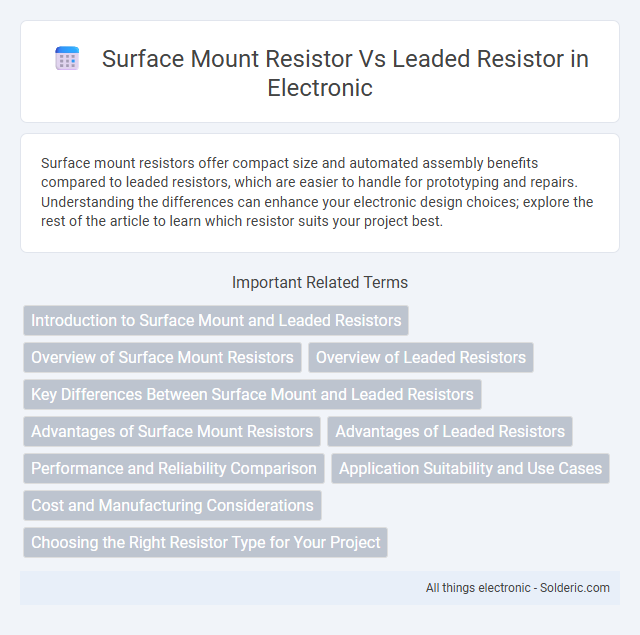Surface mount resistors offer compact size and automated assembly benefits compared to leaded resistors, which are easier to handle for prototyping and repairs. Understanding the differences can enhance your electronic design choices; explore the rest of the article to learn which resistor suits your project best.
Comparison Table
| Feature | Surface Mount Resistor (SMD) | Leaded Resistor |
|---|---|---|
| Size | Small, compact, suitable for high-density PCBs | Larger, bulky, impacts space on PCB |
| Mounting Type | Surface-mounted on PCB pads | Leads inserted through holes and soldered |
| Manufacturing | Automated pick-and-place machines | Manual or automated insertion |
| Performance | Lower parasitic inductance and capacitance | Higher parasitic effects due to leads |
| Power Rating | Typically lower (up to 1W) | Higher power handling available (up to several watts) |
| Thermal Management | Heat dissipated through PCB | Better heat dissipation via leads and body |
| Mechanical Strength | Less mechanical stress tolerance | More robust under mechanical stress |
| Applications | Compact electronics, mobile devices, precision circuits | Power electronics, prototypes, high-reliability environments |
| Cost | Lower cost in large volume production | Higher cost due to assembly labor |
Introduction to Surface Mount and Leaded Resistors
Surface mount resistors (SMRs) are compact, rectangular components designed for automated placement on printed circuit boards (PCBs), offering higher density and better performance at high frequencies compared to leaded resistors. Leaded resistors, featuring axial leads for through-hole mounting, provide ease of manual assembly and mechanical durability, making them suitable for prototyping and circuits requiring robust physical connections. Your choice between surface mount and leaded resistors depends on factors like PCB design, space constraints, and assembly methods.
Overview of Surface Mount Resistors
Surface mount resistors (SMRs) are compact, rectangular components designed for automated PCB assembly, offering higher component density compared to leaded resistors. They exhibit precise resistance values, enhanced thermal performance, and better vibration resistance due to their soldered pads rather than wire leads. SMRs are crucial in modern electronics for space-saving applications and enable efficient high-frequency circuit operations with minimal parasitic inductance.
Overview of Leaded Resistors
Leaded resistors feature axial or radial wire leads that facilitate through-hole mounting on printed circuit boards, providing robust mechanical stability and ease of manual assembly. These resistors typically offer higher power ratings and better heat dissipation compared to surface mount resistors (SMD), making them ideal for applications requiring durability under thermal stress. Commonly used in prototyping and low-volume production, leaded resistors come in various types such as carbon film, metal oxide, and wirewound, each tailored for specific electrical characteristics and precision levels.
Key Differences Between Surface Mount and Leaded Resistors
Surface mount resistors (SMD) differ from leaded resistors primarily due to their size and mounting techniques; SMD resistors are much smaller and designed for automated placement directly onto the PCB surface, offering higher circuit density. Leaded resistors feature axial leads for through-hole mounting, providing stronger mechanical bonds but occupying more space and limiting automated assembly efficiency. The electrical performance varies slightly, with SMD resistors offering lower parasitic inductance and capacitance, making them ideal for high-frequency applications.
Advantages of Surface Mount Resistors
Surface mount resistors offer significant advantages including smaller size, which enables higher circuit density and more compact electronic designs. Their automated placement and soldering process improve manufacturing efficiency and reduce costs compared to leaded resistors. Enhanced performance in high-frequency applications and better mechanical reliability under vibration stress make surface mount resistors ideal for modern electronic devices.
Advantages of Leaded Resistors
Leaded resistors offer superior mechanical stability in high-vibration environments due to their through-hole mounting, ensuring reliable circuit connections. They provide easier manual handling and soldering during prototyping and repair processes, facilitating efficient assembly and maintenance. These resistors are also better suited for high power dissipation applications, as their larger size allows improved heat dissipation compared to surface mount resistors.
Performance and Reliability Comparison
Surface mount resistors (SMRs) offer superior high-frequency performance and lower parasitic inductance compared to leaded resistors, making them ideal for advanced electronics requiring precision. SMRs provide enhanced reliability in automated assembly due to their smaller size and uniform thermal distribution, reducing the risk of mechanical stress and solder joint failure. However, leaded resistors excel in high power applications with better heat dissipation and are often preferred in environments where mechanical robustness is critical.
Application Suitability and Use Cases
Surface mount resistors excel in compact electronic devices like smartphones and laptops due to their small size and automated assembly compatibility, making them ideal for high-volume production and high-frequency circuits. Leaded resistors, with their through-hole design, are preferred in applications requiring robustness and ease of manual handling, such as prototyping, power supplies, and environments exposed to mechanical stress. Both types serve critical roles: surface mount resistors are favored in miniaturized, densely packed circuit boards, while leaded resistors remain essential in industrial equipment and repair scenarios where durability and easy replacement are priorities.
Cost and Manufacturing Considerations
Surface mount resistors generally offer lower manufacturing costs due to automated assembly processes and smaller component size, which reduces material usage and increases production speed. Leaded resistors require manual or semi-automated placement, increasing labor costs and limiting scalability in high-volume manufacturing. Your choice between these resistor types will impact overall production efficiency and budget, especially in large-scale electronic device manufacturing.
Choosing the Right Resistor Type for Your Project
Surface mount resistors offer compact size and automated assembly benefits, making them ideal for high-density circuit boards and advanced electronics projects. Leaded resistors provide ease of handling and are better suited for prototyping or applications requiring higher power dissipation and mechanical stress tolerance. Your choice depends on project requirements such as board space, manufacturing process, and electrical performance criteria.
Surface mount resistor vs leaded resistor Infographic

 solderic.com
solderic.com